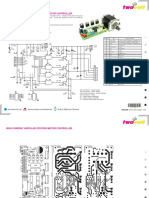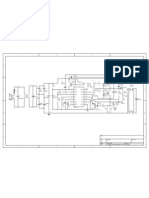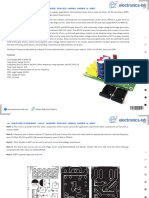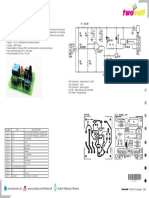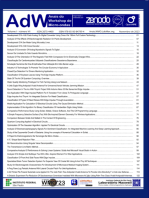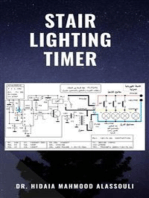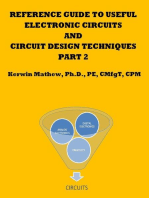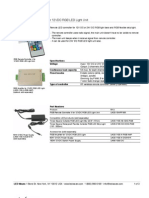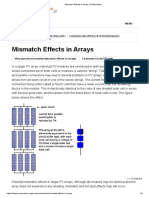LED Strobe
Uploaded by
kidal permonoLED Strobe
Uploaded by
kidal permonoLED STROBE
Design by Phil Townshend 2003
This is a basic astable driving a monostable then a Darlington driver to power the LED's. The astable is formed
using a Schmitt trigger IC1a, C3 and VR1+R2. When SW1 is pressed, the astable produces square wave pulses
of about 50/50 ratio. These are fed to a spike generator C4, VR4, D1. This shortens the pulse to enable good
resolution when measuring and can be adjust by VR2. The out put is fed to the Darlington pair to provide the
current drive. Using the transistor shown about 3A of current is available, potentially around 100 LED's.
SW2 provides an alternative trigger for the strobe, but be careful the input does not exceed 9 volts.
For calculations, see below.
D7
1N4148
9V
C2 C1
D2 D3 D4 D5 D6
10µF 100µF
R3
Enable 1K
SW1 0V 0V
R5
47
C4
470nF
R4
4.7K
IC1a
4093B IC2b
4093B IC2d IC2c
R1 Q1
4093B 4093B
1K BC337
R2 Ext. Trigger VR2
C3 D1
VR1 1K SW2 100K
4.7µF Q2
10K
TIP31C
0V
For the maths buffs...
The datasheet holds the Vpth = 6.9volts and Vnth as 3.9 volts - although about 20 values are given these seem to
be about right.
So...
To calculate the maximum flash rate, C = 4.7x10-6 and R = 1x103
Using t = τ ln (Vo/V) the time it takes for C3 to reach the positive threshold voltage will be:
t = 4.7x10-6 x 1x103 x ln ( ( 9 - 3.9 / ( 9 - 6.9 ) )
t = 4.17x10-3 seconds, or 4.17ms
This is the time for a half cyle so
f = 1 / ( 2 x 4.17 x 10-3 )
f = 119.89 Hz or 120Hz
The minimum flash rate using R as 11x103
t = 4.7x10-6 x 11x103 x ln ( 9 - 3.9 / 9 - 6.9 )
t = 10.899Hz or 11Hz
The flash time should be as low as possible without losing too much brightness.
Assuming VR2 is halfway then
t = 100x103 x 470x10-9 x ln ( ( 9 / 3.9 )
t = 0.108 seconds
LED Strobe.lvw page 1 of 1
You might also like
- DC-MOTOR-SPEED-CONTROLLER-1 Using 3525 Circuit of Oscillator PDF100% (2)DC-MOTOR-SPEED-CONTROLLER-1 Using 3525 Circuit of Oscillator PDF1 page
- Rectification: AC Full Wave Rectification - LVWNo ratings yetRectification: AC Full Wave Rectification - LVW1 page
- Unipolar Stepper Motor Driver Using Transistors and L297 1No ratings yetUnipolar Stepper Motor Driver Using Transistors and L297 12 pages
- 12V Battery Monitor and Maintainer, AVT733_ENNo ratings yet12V Battery Monitor and Maintainer, AVT733_EN4 pages
- Schematic Conversor Booster Vari├бvel, entrada 12V sa├нda 5 ├а 48V com CI UC3843 fvml100% (1)Schematic Conversor Booster Vari├бvel, entrada 12V sa├нda 5 ├а 48V com CI UC3843 fvml1 page
- Schematic - Dcto DC Converter Based On Uc3843 - Sheet 1 - 20180719202230 PDFNo ratings yetSchematic - Dcto DC Converter Based On Uc3843 - Sheet 1 - 20180719202230 PDF1 page
- Schematic - Dcto DC Converter Based On Uc3843 - Sheet 1 - 20180719202230 PDFNo ratings yetSchematic - Dcto DC Converter Based On Uc3843 - Sheet 1 - 20180719202230 PDF1 page
- Ferrite Core N87 or Similar Aviprink: in 1 Out 3100% (1)Ferrite Core N87 or Similar Aviprink: in 1 Out 31 page
- L298 and L297 Based High Current Stepper Motor Driver With Mach 3 Interface 4100% (1)L298 and L297 Based High Current Stepper Motor Driver With Mach 3 Interface 42 pages
- Describes The Rectification Procedure For The AlternatorNo ratings yetDescribes The Rectification Procedure For The Alternator1 page
- Pulsed Magnetic Field TherapyCircuit PDFNo ratings yetPulsed Magnetic Field TherapyCircuit PDF4 pages
- CAT3200DB1 Demonstration Board For The CAT3200 DC - DC ConverterNo ratings yetCAT3200DB1 Demonstration Board For The CAT3200 DC - DC Converter4 pages
- Telecine Machine: Alternative Component: IRFZ34NNo ratings yetTelecine Machine: Alternative Component: IRFZ34N1 page
- GND 1000 Uf R3 IC5 X3-1 X3-2 C9 R1: OUT 3 Disch 7 6 1 2No ratings yetGND 1000 Uf R3 IC5 X3-1 X3-2 C9 R1: OUT 3 Disch 7 6 1 21 page
- Speed-Up For Darlingtons: Small Circuitscollection100% (1)Speed-Up For Darlingtons: Small Circuitscollection1 page
- Reference Guide To Useful Electronic Circuits And Circuit Design Techniques - Part 2From EverandReference Guide To Useful Electronic Circuits And Circuit Design Techniques - Part 2No ratings yet
- SMD Type IC: Three-Terminal Negative Voltage Regulator LM79L12No ratings yetSMD Type IC: Three-Terminal Negative Voltage Regulator LM79L121 page
- SEMIKRON DataSheet SKS 425N B6U 285 V16 SU 08785115No ratings yetSEMIKRON DataSheet SKS 425N B6U 285 V16 SU 087851152 pages
- A Study On Insulation Coordination of A Wind Turbine Generator System and A Distribution Line100% (1)A Study On Insulation Coordination of A Wind Turbine Generator System and A Distribution Line6 pages
- Power Electronics Slides and Notes DC ConvertersNo ratings yetPower Electronics Slides and Notes DC Converters40 pages
- Aircraft External Lights System: A Project OnNo ratings yetAircraft External Lights System: A Project On37 pages
- Investigation On The Crystallinity and Optoelectronic Properties of Thin Films of Zno/mapbx3heterojunctionsynthesized Via The Spin-Coating MethodNo ratings yetInvestigation On The Crystallinity and Optoelectronic Properties of Thin Films of Zno/mapbx3heterojunctionsynthesized Via The Spin-Coating Method8 pages
- IEEE Standard Test Procedure For AC High-Voltage Circuit Breakers Rated On A Symmetrical Current Basis0% (1)IEEE Standard Test Procedure For AC High-Voltage Circuit Breakers Rated On A Symmetrical Current Basis60 pages
- A Project Report On: "Two Axis Solar Tracking System"No ratings yetA Project Report On: "Two Axis Solar Tracking System"13 pages
- (IJET-V1I2P11) Authors :abdul Latif Saleem, Raja Sagar R, Sachin Datta N S, Sachin H S, Usha M SNo ratings yet(IJET-V1I2P11) Authors :abdul Latif Saleem, Raja Sagar R, Sachin Datta N S, Sachin H S, Usha M S4 pages
- Description Features: The Future of Analog IC TechnologyNo ratings yetDescription Features: The Future of Analog IC Technology20 pages
- Synthesis and Characterization of Cacu Ti O and Lanthanum Doped Cacu Ti O by Auto-Combustion TechniqueNo ratings yetSynthesis and Characterization of Cacu Ti O and Lanthanum Doped Cacu Ti O by Auto-Combustion Technique73 pages
- Mismatch Effects in Arrays - PVEducation PDFNo ratings yetMismatch Effects in Arrays - PVEducation PDF4 pages
- Multiple Re-Strikes Phenomenon When Using Vacuum CircuitNo ratings yetMultiple Re-Strikes Phenomenon When Using Vacuum Circuit8 pages
- Regulated Power Supply Semester PresentationNo ratings yetRegulated Power Supply Semester Presentation14 pages
- Merits and Limitations of Circular TLM Structures For Contact Resistance Determination For Novel III-V HBTsNo ratings yetMerits and Limitations of Circular TLM Structures For Contact Resistance Determination For Novel III-V HBTs6 pages
- My Tesla's Radiant Energy Collector (Open Project)100% (1)My Tesla's Radiant Energy Collector (Open Project)10 pages










